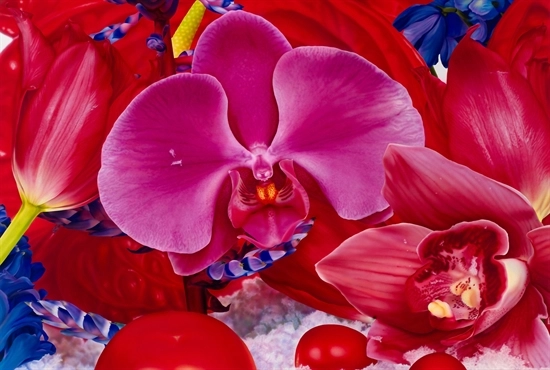
The floral motif is one that has been used by artists for centuries, from Jan Brueghel the Elder’s lavish still lifes of flower arrangements to Georgia O’Keeffe’s close-up studies of calla lilies to Andy Warhol’s iconic Pop flower prints. Even contemporary artists like Damien Hirst have been captivated by the allure of blooms, who completed his series “Cherry Blossoms” in 2020. Flowers are frequently employed by artists for their symbolism, whether as an allusion to memento mori or a reference to spring and rebirth.
To highlight notable works in Artnet’s Contemporary Finds sale, we spoke with three of our specialists about three featured artists who engage with the symbolic and intriguing flower motif. All three works are live for bidding on Artnet Auctions through December 15, 2022.
Jonas Wood
Notepad Doodle 2 (State II) (2018)
Jonas Wood, Notepad Doodle 2 (State II) (2018). Est. $6,000–$8,000.
Working across the mediums of painting, drawing, and prints, Jonas Wood (b. 1977) draws inspiration from his life, producing images of the people, objects, and interiors that he encounters daily. His distinct artistic style, which is noted for its flat planes of color and refusal of vantage point, results in a cohesive world of his own making. Wood is also influenced by art history, looking to traditional genre paintings and historical artists as starting points from which he can transform the mode into something radically contemporary and of his own style.
“Known for his blocky, graphic depictions of domestic interiors, artist Jonas Wood continues his career-long interest in the flower motif with Notepad Doodle 2 (State II) (2018). Consisting of several plants housed in vessels created by his wife, artist Shio Kusaka, the work recalls the colorful cutouts of Henri Matisse. Like much of Wood’s work, this is an exploration of both the legacy of still life and the artist’s ability to draw endless inspiration from his everyday surroundings. I find that the printmaking medium also lends its ideality for the artist to further express the floral subject matter in his personal iconography of flattened planes and shapes.
An interesting fact about this work is that the artist came to create the ‘Notepad Doodle’ series after drawing on hotel stationary during a trip. He brought the doodles back to his studio and began making giant versions of the notepad creations.” —Lauren Whitton, Specialist, Prints and Multiples
Orlanda Broom
Flutter (2022)
Orlanda Broom, Flutter (2022). Est. $10,000–$15,000.
British artist Orlanda Broom (b. 1974) has an oeuvre delineated by two distinct typologies: luxuriant floral landscapes and flowing abstractions. Her floral landscapes, like the one included in Artnet’s current auction, are an interpretation of the natural world—one where everything is lush, brightly colored, and hyperreal. Its perfection, however, alludes to a darker theme, one that reminds the viewer that the landscape is decidedly not real, and refers to a natural landscape that has been lost to us.
“I enjoy this painting because at a quick glance it appears like an everyday subject, but after taking a closer look at the colors the whole thing seems highly improbable—yet I keep looking at each element and detail, thinking they’re created from observation. Fun fact, the artist has a major commission at the Four Seasons hotel behind our New York offices, near the entrance to the wine bar Cut. The scale is incredibly large and impressive. It makes you feel like you’re lost in the fiction, and that’s what I enjoy about art.” —Jason Rulnick, Senior Specialist, Contemporary Art
Robert Mapplethorpe
Tulip (1988)
Robert Mapplethorpe, Tulip (1988). Est. $30,000–$50,000.
Robert Mapplethorpe (b. 1946) is perhaps best known for his transgressive black-and-white photographs of the queer community. His forays into color, however, and specifically his studies of flowers, proved him a master of the medium, and exemplify his skill with the technical and traditional fundamentals of the medium, such as line, texture, and color. Many have considered his floral studies to also be an extension of his exploration of eroticism, as the compositions and the sensuous shapes of the flowers frequently allude to the human form.
“In the years leading up to his death, Robert Mapplethorpe turned his lens to flowers, distilling them to their most essential forms in a controlled studio setting. The striking simplicity of the composition and blood-red interior alludes to the sexuality and violence present in Mapplethorpe’s figurative work. The richness of the color from the dye-transfer medium is also remarkable. This color process is no longer available due to the chemicals and papers being discontinued.” —Susanna Wenniger, Head of Photographs
Browse these works and 65 more by artists including Marina Abramović, Wolfgang Tillmans, and Marc Quinn in the Contemporary Finds auction, now live through December 15, 2022.